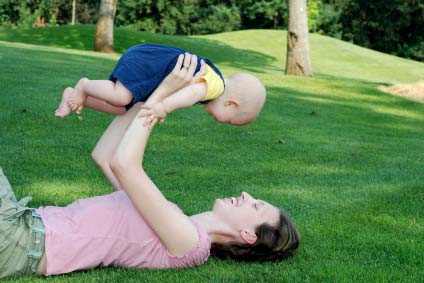
Go Green for Baby
Unless you’re in line to be the head of the Environmental Protection Agency, cleaning up the planet can seem like a task too big for one person—and hey, it is. But small steps can help. Whether you simply buy the right fresh food or use the right kind of diapers, here are five tips to make your household healthier and your family part of the solution.
Clear the Air
If you believe exhaust fumes and smog are the only air pollution you have to shield your child from, think again. “Indoor air is five to ten times more polluted than outdoor air,” says Christopher Gavigan, CEO and executive director of the Children’s Health Environmental Coalition. From chemicals in synthetic carpets to sealers on furniture, hidden threats can release doses of toxic gas into your home. Gavigan recommends using an air purifier to clean up the air inside (be sure to change its filter regularly). If you can’t get your hands on a purifier, try opening the window for 20 minutes a day to let in some fresh air.
Sanitize Sensibly
Little ones’ hands are hot spots for germs, but there are loads of good
bacteria on those hands too. In fact, that good bacteria helps fight
the bad. Hand sanitizers not only zap those bad bacteria, they also
wipe off the good. The next time you want to get those sticky fingers
clean, Gavigan recommends using traditional hand soap. Classic hand
washing gets the job done, while keeping that good bacteria fighting.
Cottony Goodness
If you’re looking to get green early, it’s best to start at the bottom of things, literally. The Real Diaper Association
estimates that over 27.4 billion disposable diapers are consumed each
year, loading our environment with unwanted paper and traces of
chemicals like dioxin, a byproduct from paper-bleaching. Instead of
tossing out tons of disposables, try using cloth diapers, suggests Lori
Taylor from the RDA. Not only are cloth diapers a more environmentally
friendly way to swath your baby’s bottom, they’re also more economical.
If you’re too busy for the cloth solution, try a disposable like
Seventh Generation’s Chlorine-Free Diapers.
Be a Local Yokel
One reason organic produce tends to be more expensive is transportation
cost. For an economical alternative, Gavigan suggests buying local
produce (which might also be grown organically). It’s less
resource-intensive, and the produce travels less distance, which means
you’re getting your food fresher and cheaper.
DIY Baby Food
Buying that jarred stuff off the shelves means you might be feeding
your baby food that’s older than she is. Why not make your own with
fresh produce? Margaret Meade, the editor and owner of wholesomebabyfood.com,
recommends starting with food that’s easy to digest like banana,
avocado, and sweet potato. As your child and her tastes develop, try
mixing in new foods and flavors to educate taste buds. “You raise your
own conscious level and you’ll end up making better food choices for
your child from toddler on,” Meade says. If you haven’t got the time to
blend your own creations, try a frozen organic baby food like Plum Organics, which is flash-frozen to seal in nutrients.
© Copyright 2006, Rodale Publishing. All Rights Reserved.

